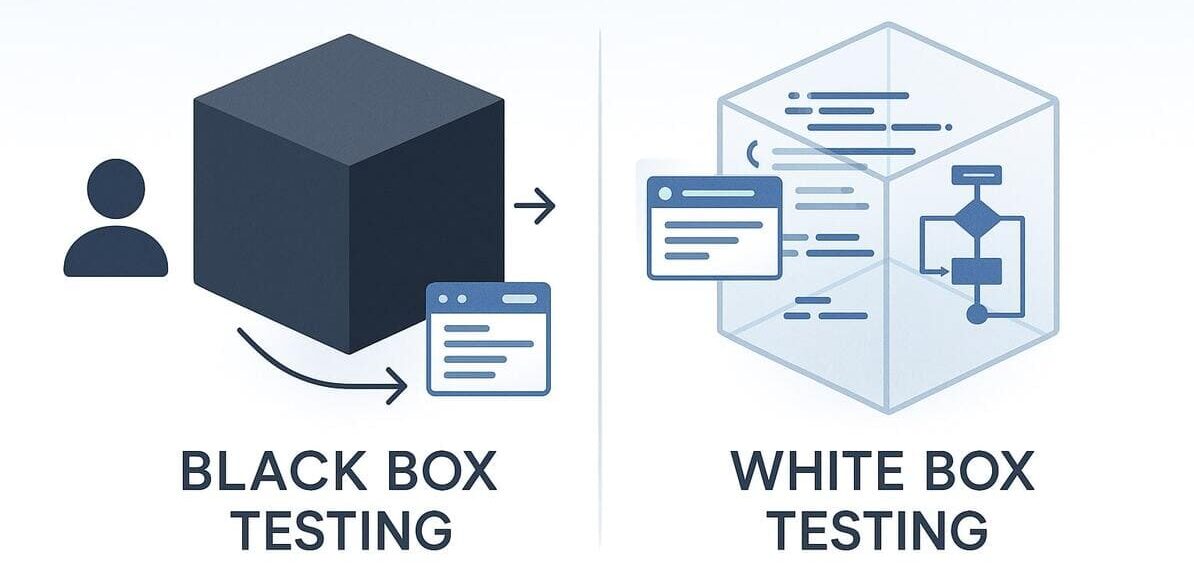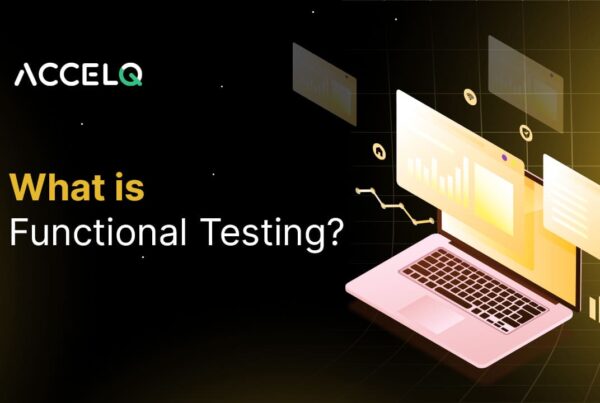Black Box vs White Box Testing: Key Differences & When to Use Each in Your QA Strategy

A robust testing strategy is essential for delivering reliable, superior-quality apps. Amongst the core methods, Blackbox vs White Box testing stands out as a fundamental comparison that outlines how testing is planned and implemented. While white box and black box testing vary in visibility into the testing techniques & code, both are critical elements of a comprehensive QA strategy. This article discovers the core advantages, differences, & ideal scenarios for applying every technique efficiently in your SDLC.
What Is Black Box Testing?
Black box technique involves testing the software without visibility into its internal logic, allowing QA engineers to validate functionality solely through external behavior. The concentration is purely on inputs, projected outcomes, and how the software acts under particular situations. Used in both unit and integration testing, this technique allows developers to isolate and test individual code branches, exposing performance concerns, security vulnerabilities, and logical inconsistencies.
What Is White Box Testing?
It is also called clear-box or structural testing, and it necessitates insight into the app’s internal code and logic to validate its correctness and efficiency. QA engineers with programming knowledge create test cases based on logic paths, conditions, loops, and code structure. This method is essential for integration and unit testing, helping identify security flaws, logic errors, and performance bottlenecks by testing individual code paths.
Differences Between Black Box and White Box Testing

Mastering black-box and white-box testing techniques is key to formulating a sound QA approach and making informed testing decisions. These two denote opposite ends of the test spectrum, where one concentrates on features, and the other dives into code structure.
The difference between black box vs white box testing depends on the approach and visibility. Black box testing is carried out without the internal code being known. It assesses the software based on user interactions, confirming it behaves as projected under multiple situations. Conversely, white box testing necessitates deep knowledge of the codebase. QA engineers can check logical paths, internal operations, and code accuracy through code scrutiny and unit testing.
Combining both techniques can help guarantee dynamic test coverage, verifying the software’s functionality and methods.
Pros and Cons of Each Approach
QA teams can select the best approach or combination for specific testing goals by being aware of the advantages and disadvantages of black box vs white box testing.
Black Box Testing
Pros:
- Verifies real-world functionality through user-perspective testing.
- Perfect for non-technical testers, no coding experience is required.
- Assists in identifying integration, usability, and interface problems.
- Effective for big systems with inaccessible internal code.
Cons:
- Lacks visibility into code structure, making it difficult to detect hidden logic errors.
- It is challenging to obtain complete test coverage.
- Redundant or inefficient test cases might happen due to insufficient internal knowledge.
White Box Testing
Pros:
- Complete access to internal logic enables great coverage and deeper scrutiny.
- Allows testing of loops, conditionals, and edge cases.
- Helps detect security vulnerabilities, hidden bugs, and performance glitches.
- Suitable for integration and unit testing.
Cons:
- Demands code access and programming skills.
- Might miss UI/UX problems or user-centric errors.
- This method doesn’t scale well and can slow testing in larger applications.
When should you use each in your QA strategy?
Selecting between black box vs white box testing depends on your team structure, app stage, and test objectives. Here’s a quick overview to help determine the appropriate context for each approach.
Use Black Box Testing When
- You wish to authorize the system from an end-user perspective.
- QA engineers are non-technical and don’t have access to the codebase.
- Performing User Interface (UI), system, or acceptance testing.
- You are emphasizing integration, usability, or functionality with external systems.
- Ease and speed are the main priorities in early-phase testing.
Use White Box Testing When
- You need comprehensive confirmation of internal code paths and logic.
- Software developers are engaged in the testing process.
- Performing integration or unit testing during development.
- Performance, security, or code-level errors are a big concern.
- You are striving for extreme code coverage.
Combine Both for Higher Coverage
In various DevOps and agile environments, combining both approaches guarantees strong quality. Use black box testing to confirm real-world functionality and UX, and white box testing early in the SDLC for detailed code validation. This balanced strategy supports QA experts in efficiently covering both black and white box in software testing.
ACCELQ: Unifying Black Box and White Box Testing with No-Code Intelligence
This is one of the incredible codeless test automation tools that serves as a robust platform that removes the traditional divide between black box and white box testing. ACCELQ provides an entirely unified approach through AI-based, codeless automation.
Core ACCELQ Features That Bridge Black Box and White Box Testing:
- AI-based No-Code Test Automation on Cloud: Allows non-tech and tech users to generate comprehensive test suites without crafting code.
- Rapid Automated Test Development with Lowest Maintenance: Allows fast script generation and smart maintenance using AI-centric self-healing mechanisms.
- Combined Automation Across API, Web, Desktop, and Mobile: Automates across distinct platforms and layers within a single, allied flow.
- In-Sprint Automation: Supports DevOps and Agile systems by allowing automation to be built and implemented within the sprint cycle.
- Zero programming is needed for manual QA testers: It makes automation available to manual QA engineers and business users with an in-built visual interface.
- Visual App Model for Business Process Authentication: Provides a top-level, visual demonstration of business logic to make parallel testing with functional systems.
- Self-Healing Autonomic Automated Testing: Dynamically adapts to app modifications, guaranteeing test accuracy during frequent launches.
- AI-centric Test Case Creation and Data Planning: Accelerate test coverage by automatically creating testing and smartly managing test data.
- Built-in version control, Test Management, and Governance: Gives enterprises collaboration, compliance, and traceability capabilities.
- Smooth CI/CD Integration: Seamlessly integrates with tools such as Jira, GitHub, and Jenkins and pipelines to support E2E continuous and automation testing.
By blending these advanced features, this pristine tool streamlines black box vs. white box testing and transforms automated testing into a scalable, collective, and intelligent procedure. It’s a perfect answer for QA experts aiming to decrease technical debt, enhance productivity, and align testing with advanced delivery practices.
Conclusion
Designing a comprehensive QA plan requires understanding the distinctions between black box vs white box testing. While black box testing examines the functionality from an end-user perspective, white box testing verifies functionality from the end-user’s perspective, without examining the internal code. Together, their distinct advantages provide thorough test coverage.
It is simpler to combine both strategies on a single platform with the help of tools like ACCELQ. ACCELQ’s AI-powered, no-code features enable testers of all technical skill levels to automate intricate backend and user interface operations. ACCELQ offers the intelligence and scalability your testing strategy requires, whether your goal is to improve test efficiency or to conform to Agile and DevOps standards.
Are you prepared to unify your testing with ACCELQ? Try it now by clicking ACCELQ Contact us and transform your QA process.
Prashanth Punnam
Sr. Technical Content Writer
With over 8 years of experience transforming complex technical concepts into engaging and accessible content. Skilled in creating high-impact articles, user manuals, whitepapers, and case studies, he builds brand authority and captivates diverse audiences while ensuring technical accuracy and clarity.
You Might Also Like:
 Why User Acceptance Testing Is Critical for a Successful ERP Implementation
Why User Acceptance Testing Is Critical for a Successful ERP Implementation
Why User Acceptance Testing Is Critical for a Successful ERP Implementation
 15 Types of Testing Every QA Must Know
15 Types of Testing Every QA Must Know
15 Types of Testing Every QA Must Know
 Software Functional Testing: Process, Automation & Best Practices
Software Functional Testing: Process, Automation & Best Practices
































